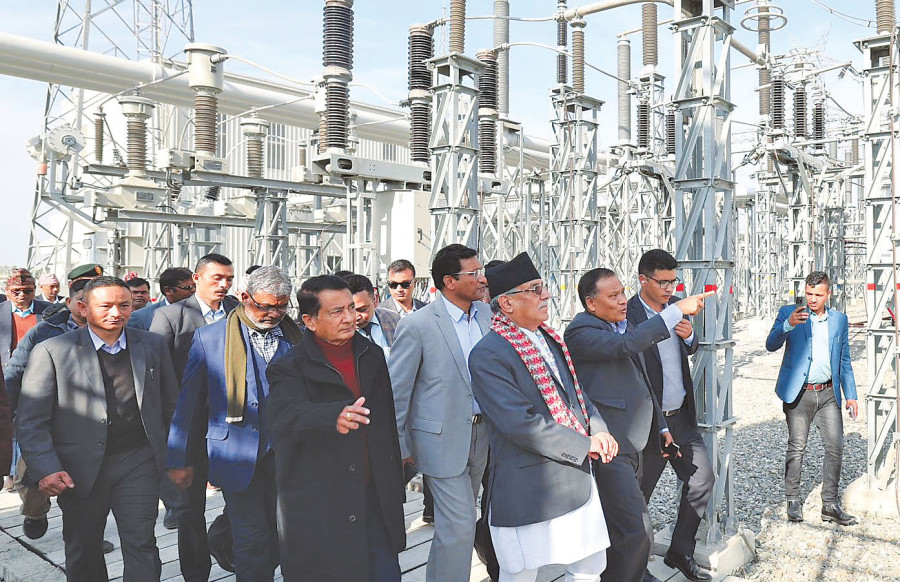National
High-capacity Inaruwa substation will smoothen power supply within Nepal and across the border
Prime Minister Pushpa Kamal Dahal inaugurates the project that will enable supply of 4,000 MW electricity.
Post Report
A high-capacity transmission substation at Inaruwa, Sunsari was inaugurated on Friday, enabling the Nepal Electricity Authority to transmit more power domestically and trade more electricity with India.
Prime Minister Pushpa Kamal Dahal inaugurated the 400kV substation, a gas-insulated system-based substation that is the largest in the country after the Dhalkebar substation. According to the power utility, the infrastructure will enable the transmission of up to 4,000MW of electricity once the construction of the 400kV Inaruwa-Dhalkebar Transmission Line is over.
The high-capacity substation, whose construction was completed in October, was inaugurated at a time when the NEA has been struggling to supply electricity from both east to west and west to east. This has resulted in an unreliable supply of power for industries in the Sunsari Morang Industrial Corridor and the Bara Parsa Industrial Corridor.
NEA officials say the newly built substation is also important for the trading of electricity between Nepal and India through the proposed 400kV Inaruwa-Purnia Cross Border Transmission, and the proposed 400kV Inaruwa-Anarmani Transmission Line within Nepal. The second line has been designed to enable power trading with both India and Bangladesh.
“The Inaruwa substation has become a major hub for supplying electricity from the east to the west or vice versa within Nepal, supplying more power to India and promoting regional trade in electricity,” NEA Managing Director Kul Man Ghising was quoted saying in a statement.
“This substation is considered important to supply dedicated power to the industries based in the Morang-Sunsari Industrial Corridor and to improve the quality and reliability of electricity transmission.”
In recent years, industrialists in the region have complained about irregular power supply, particularly in the dry season or in winter when domestic plants produce around a third of their capacity, making power import from India necessary.
Improved infrastructure is essential to ensure a reliable supply of power at home and abroad, according to NEA officials. Construction of the 400kV substation is a part of improving the power infrastructure, they said. The NEA has been stating that since ending power outages in the country in 2018, its main priority has been to improve its transmission and distribution infrastructure.
Construction of the substation was completed at a time when India has pledged to buy more power from Nepal and even Bangladesh eyes Nepal’s clean energy.
When Prime Minister Pushpa Kamal Dahal visited New Delhi from late May to early June, Nepal and India initialled a 25-year long-term power trade deal under which the southern neighbour committed to buy 10,000 megawatts in 10 years.
During the inauguration of the substation, Prime Minister Dahal said a long-term agreement would soon be signed in Nepal, inviting high-level officials from India. This will be an important and historic moment for Nepal’s hydropower, he added.
Besides the Inaruwa substation, completion of the under-construction Hetauda-Dhalkebar-Inaruwa line is also essential for trading more power through the Dhalkebar-Muzaffarpur cross-border transmission line, according to NEA officials.
Currently, the transmission line is being set up along the Dhalkebar-Inaruwa section, the NEA stated. The power authority expects to complete the Hetauda-Dhalkebar section of the project by July next year, NEA officials said. The Hetauda-Dhalkebar-Inaruwa Transmission Line was initially funded by the World Bank. In 2021, the global lender pulled out, citing delays in project implementation.
The government has since been developing the project with its own funds. The Inaruwa substation has provided the ground for supplying more power from projects being developed in eastern Nepal.
According to the NEA, the substation makes it possible to supply more power to it from hydropower projects being developed in Arun and Tamor rivers and their tributaries. The power from those projects will be brought via the 220kV Koshi transmission corridor, parts of which have already been completed, the power body said.
A contract was awarded to Siemens Limited, India in December 2018 to construct two substations—one at Inaruwa and the other at Hetauda. The combined cost of project implementation stood at Rs413.82 million, the NEA said. The Inaruwa substation cost as much as Rs204.8 million.




 16.12°C Kathmandu
16.12°C Kathmandu














